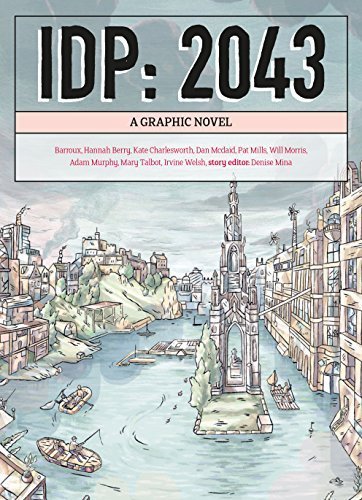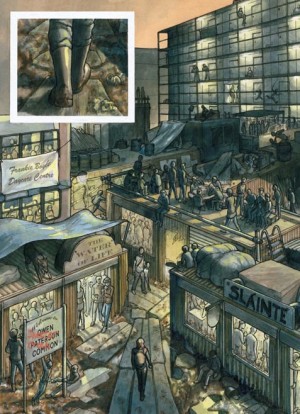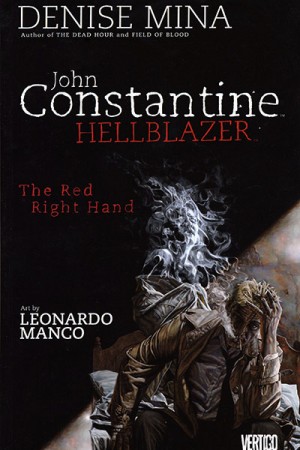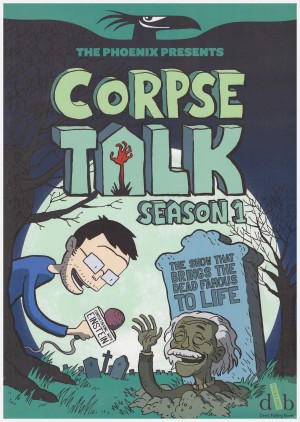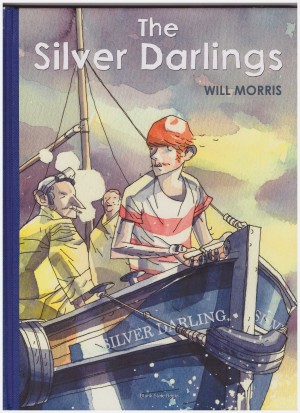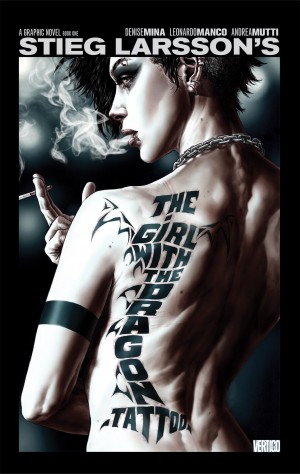Review by Graham Johnstone
It’s 2043 and the sea levels have risen, leaving the population of Britain no choice but to abandon the old cities and relocate to higher ground.
That’s the premise of this graphic novel realised by the Stripped programme of the Edinburgh International Book Festival. It marks the 30th anniversary of the Festival by looking thirty years into the future. It’s a bold and laudable venture, and encouraging that it’s publicly funded.
It’s a creative collaboration too – helmed by novelist turned comics writer Denise Mina, with different teams producing different chapters. There’s a broad spectrum of talent involved, mostly with connections to Scotland or the festival. Some chapters read as self-contained stories, while adding up to a kaleidoscopic novel.
It’s kicked off by 2000AD veteran Pat Mills, a man at home with dystopias. Partnered with artist Hannah Berry (sample image), he introduces us to Cait, who lives in a shipping container, and is the proletarian voice-of-the-people on ‘reality TV’ show Sky Farm. The show aims to promote, new ‘solutions’ to feeding everyone. Cait, though has caught the attention of a committee of powerful people who decide she is an obstacle that needs to be dealt with.
Will Morris’s chapter focusses on boxer Tom Sayers. We see his backstory through an effective montage of boxing posters and fragments of bouts. In the present though he’s a reluctant heavy, working for a Mr Gartman, on – it slowly becomes clear – events we saw in the previous chapter. There’s that kaleidoscopic effect.
In Adam Murphy’s chapter, Cait’s co-presenters Danny and Jools host an exclusive dinner party in their luxurious Sky Farm apartment. Cait ends up being somewhat forthright. She questions the very need for Sky Farm: after all, there’s still plenty of land above the water. This device provides some back story and exploration of the issues, while acknowledging that this, like Cait herself, is the not entirely welcome guest at the party.
It’s a coup for the editors to secure the comics debut of Irvine Welsh, author of hit novel and film Trainspotting. He provides a powerful back-story for the ruthless Gartman, but it falls down somewhere between him and illustrator Dan McDaid. It reads like a prose story illustrated, and McDaid’s visualisation here is redundantly noir, as well as murky and inexact in both rendering and storytelling. He blows the visual clues that distinguish two adversaries in suits: one’s jacket is buttoned, then open, and his tie changes colour between panels.
Mina’s chapter, in contrast, has almost absurdly minimal text. One page just contains: “Good.” “Great!” “…No”. She trusts Frenchman Barroux to carry the story in his simple but stylish ‘artoons’. Careful reading reveals we’re seeing Danny and Jools, as they maintain a positive front for Sky Farm in the face of Cait’s challenges, and revelations of realities both inside and outside. We also see their connection to Gartman and earlier events.
Mary Talbot has perhaps the toughest job – writing the conclusion. It resolves the plot and makes a breakthrough on the issues, while heavy on the exposition, and perhaps unduly optimistic. Kate Charlesworth does an commendable job of keeping this section (with ten pages in a boardroom!) visually interesting.
Most of the art is rendered in washes – reflecting perhaps, the encroaching water. Will Morris does it best – with stylish lines, and tones that are both confident and subtle – a real talent to watch.
This is a bold project, thoughtfully executed. It explores important issues for our present and future, only occasionally tipping into a lecture. Like an anthology though, some contributions will appeal more than others.
